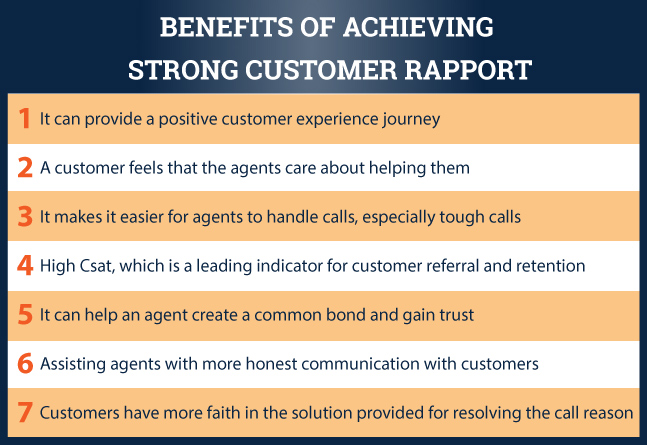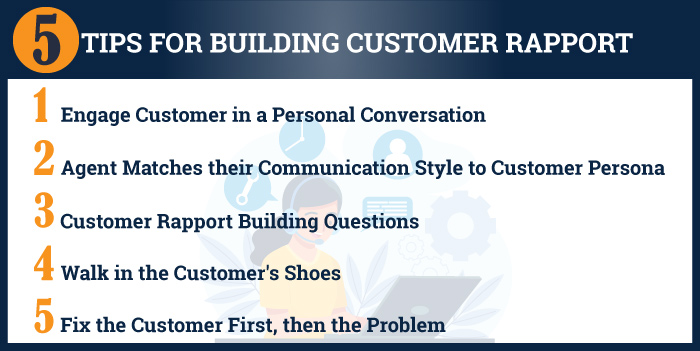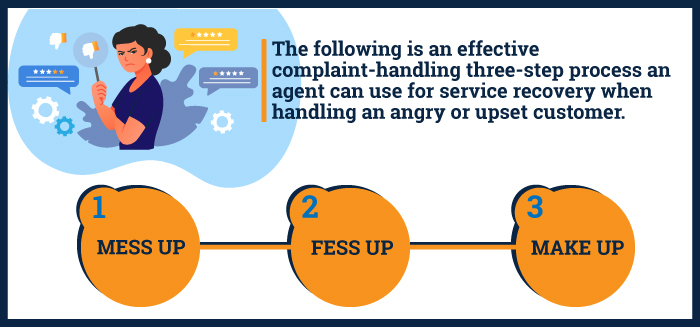What is Customer Rapport?
Customer rapport is about establishing and maintaining a positive customer journey to resolve inquiries or problems. Building customer rapport is one of an agent's most essential skills to deliver great customer service.

When an agent builds a good rapport, the customer experience (CX) becomes easier for them to handle the call and can help create high customer satisfaction (Csat) and First Call Resolution. Furthermore, when an agent builds customer rapport, it can go a long way toward creating a common bond and gaining customer trust.
Why Is Customer Rapport Important?
SQM Group's customer service research shows that building customer rapport is the second biggest driver for achieving high call center Csat. Only an agent resolving a call is a more significant driver for providing high Csat.

Therefore, building customer rapport is essential for agents to achieve for the customer to have a positive impression of the company. Furthermore, there are other benefits of achieving strong customer rapport, such as:

What Is the Biggest Challenge In Building Customer Rapport?
There are many challenges hindering agents from building customer rapport. However, one of the biggest challenges for agents is handling 40 to 60 calls daily and the monotony of handling calls. Therefore, many agents can be unmotivated to handle all calls with the desire to achieve high customer rapport.
Many agents describe their job as performing the same tasks over and over. As a result, agents feel under-stimulated and demotivated to build customer rapport. In addition, many agents fail to recognize that their customer interfacing job provides them with an opportunity to help customers by building rapport with them and engaging customers with interesting conversations to help them resolve their interaction.

Therefore, it is vital that agents not only understand the importance of building customer rapport but can demonstrate it in every interaction. This can be challenging for agents, especially when you consider the agent and customer conversations happening over the phone versus face-to-face. Agents can not see the customer's facial and body language, which can be a hindrance to building customer rapport.
How to Build Customer Rapport?
Building customer rapport over the phone is an essential skill all agents must have to deliver great Csat. Again it is important to remember that the customer rapport moment of truth (MoT) is the second most crucial MoT for achieving high Csat.
However, building customer rapport over the phone can be very challenging when you consider you can't see someone's facial and body language expressions. Therefore, agents must use other verbal communication methods to build customer rapport.
Here are five tips for building customer rapport:

1. Engage the Customer in a Personal Conversation
On one end of the spectrum, call centers are driven by focusing on average handle time (AHT) and script adherence to lower operating costs. On the other end of the spectrum, call centers treat all customer interactions as an opportunity to deliver great customer service.
Most call centers have a balanced approach of being cost and service driven, which in many cases can mean they are only half-committed to being either cost or service driven. Furthermore, the half-commitment approach is probably one of the main reasons why most call center Csat is either average or good but not great.
Call centers with great Csat show genuine interest in customers by engaging them in a personal conversation. They have eliminated or been less strict with agent AHT and script requirements, allowing agents the time to build customer rapport. At the appropriate time during the call, an agent can start to have a personal conversation to build customer rapport by using positive words. Csat and QA metrics can be used to ensure there is no abuse or misuse of customer rapport techniques.
A good way for agents to build rapport is to ask customers questions about general topics (e.g., location, weather, family, sports) unrelated to their call or the products and services they use. However, the agent must remember that a personal conversation should never cross a line or be (e.g., unwanted small talk, invasion of privacy, or being insincere).
Agents asking questions about products and services will help them learn more about customers and make them feel important and valued. Furthermore, when agents ask the right questions, customers have higher confidence that agents are knowledgeable about the company's products and services.
2. Agent Matches their Communication Style to Customer Persona
Most agents cannot identify the different persona styles (i.e., supporter, influencer, analyzer & driver) of the customers who call them. In addition, agents are not trained to be adaptive to match their communication style to the persona communication styles of the customers calling them. Therefore, most call centers do not understand the impact of different customer and agent persona communication styles on Csat.
Our research shows that each persona has a significant percentage distribution, which suggests that for an agent to provide a great customer experience and improve Csat, they need to understand each persona style. By quickly identifying the customer's persona communication style, an agent can potentially avoid the behaviors that can create poor customer experiences by using behaviors and word choices that match the customer's persona communication style.
While there are many ways a call center can measure communication styles, at SQM, we believe the best practice for identifying persona communication styles is to let the customer be the judge. SQM's persona communication styles approach is unique because it is based on post-call surveys using mySQM™ Customer Service QA software for identifying personas. Also, with persona communication styles, you need to train agents to adapt their communication style to match the customers they are talking to.
Matching an agent's communication style to a customer's persona communication style will assist in building customer rapport and enhance their experience in doing business with your organization, resulting in higher call resolution and Csat ratings. Each persona impacts the preferred way a customer and an agent act, think, and makes decisions. By identifying the persona communication style, an agent can use behaviors and word choices that match the customer's persona communication style.
3. Customer Rapport Building Questions
Using questions can be an effective way to build customer rapport. When asking customers questions, it is essential to use open-ended questions to ensure a good dialog. For example, using the Five W's and how (e.g., what, why, where, who, and when) questions can be helpful for agents to learn more about the customer and establish two-way communication. Below are examples of open-ended general questions:
- What would you like us to do to resolve your issue?
- How's your day going?
- How can we earn your trust?
- Why do you want to change your health plan?
- What would you like us to do to improve your CX?
It is difficult for agents to empathize with a customer unless they understand their situation thoroughly. For an agent to sincerely empathize with a customer, they should use the following phrase - Let me summarize your key points to ensure my understanding. Furthermore, the use of questions for understanding customer situations can be beneficial for building customer rapport. These questions focus on a customer's goals, needs, or problems. Below are examples of understanding customer situation questions:
- What are your overall goals or top priorities?
- Can you tell me more about your needs?
- What do you think the problem keeps happening?
- What is not working that you want to change?
- What keeps you up at night?
Another effective questioning technique is using closed-ended questions such as do, did, is, can, will, and would to help build customer rapport. With closed-ended questions, customers respond with a short response such as yes or no. When appropriate, the key is to use a follow-up question to determine why the customer said yes or no. Below are examples of closed-ended general questions:
- Would it be helpful if I clarified what I meant?
- Did I resolve the reason for your call today?
- Did I give you clear next steps or options to resolve your call today?
- Will that meet your needs?
- Do you understand what is needed to be done to resolve your inquiry?
4. Walk in the Customer's Shoes
Showing empathy is essential for creating trust and building customer rapport. Call center agents must put themselves in the customer's shoes to understand their perspective. Moreover, these agents need to show that they care about helping customers by being empathic.
For example, if an agent shows empathy while resolving a challenging and important issue, it will help create trust and the customer's feeling that the agent understands their situation. Furthermore, the fundamental belief is that customers trust agents who believe they understand them. Thus, if an agent does not show empathy, customers will not trust them and will not likely be able to build customer rapport.
Even though agents try to see the experience through the customer's eyes, they sometimes don't or can't because they are conditioned to see it through the company's eyes. As a result, it's often difficult for agents to separate themselves from what they think the customer perceives versus what the customer experiences.
Agents need to pay attention to what the customer is saying because it is one of the best ways to show empathy. For instance, an agent should listen to subtle clues about the customer's mood and personality to be able to walk in the customer's shoes and show empathy. In addition, paying attention to what the customer is saying will help agents make the right decision to help customers resolve their inquiries or problems.
5. Fix the Customer First, then the Problem
It's normal for an agent to want to respond to everything a customer says on a complaint call. For example, during a long-winded customer rant, an agent might want to interrupt what the customer is saying and provide a solution. However, in most cases, it is best to take a step back and let the customer vent, listen closely to what they are saying and show empathy.
Furthermore, it has also been SQM's experience that agents need to get better at fixing customer problems and their ability to handle the emotional aspects of the customer's call. Therefore, a best practice tip for an agent is to acknowledge the customer's situation (i.e., the emotional aspect of the customer's call) first and then resolve the call. Put differently, an agent should first fix the customer's emotions and then fix the problem.
Many angry or upset customers have meager expectations that their issue or problem will get resolved to their satisfaction. However, dealing with an angry customer represents an excellent opportunity to meet or exceed their expectations to resolve the issue or problem. Put differently, a customer complaint is a gift because you get the chance to deliver service recovery and learn from mistakes.
The following is an effective complaint-handling three-step process an agent can use for service recovery when handling an angry or upset customer.

1. Mess Up
Allow the customer to tell their side of the story and vent their frustration without being interrupted. The agent acknowledges that they have heard the customer using words such as uh-huh, hmm, I see, and tell me more. Listening to the customer and letting them vent allows them to calm down.
2. Fess Up
Ask questions to ensure understanding of the issue or problem. Agent restates the issue or problem to confirm that they fully understand. Agent apologizes for the organization's mistake or expresses empathy for the customer's situation. If a full agreement between the customer and agent cannot be reached on the issue or problem, try to seek a partial agreement on the issue or problem to help defuse the customer's anger.
3. Make Up
An agent needs to make the customer problem their problem. Simply put, an agent takes ownership. Resolve the customer's issue or problem to their satisfaction. Many customers have low expectations that their issues will get resolved to their satisfaction. By providing a solution or solution options to resolve their issue or problem, you have an opportunity to meet or exceed the customer's expectations. The agent should confirm with the customer that there is agreement that the solution or solution options will resolve the customer's issue or problem (e.g., Have I resolved your issue or problem?).
Quick Related Links
First Call Resolution Comprehensive Guide Customer Satisfaction Comprehensive Guide Agent Coaching Customer Quality Assurance VoC Closed-loop Good to Great Customer Service
